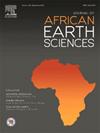A post-ophiolitic plutonism record in the Central-East Iranian Microcontinent: Evidence for Pre-Eocene age of Neo-Tethys subduction
IF 2.2
4区 地球科学
Q2 GEOSCIENCES, MULTIDISCIPLINARY
引用次数: 0
Abstract
The Eocene Kalut-e-Ghandehari (KG) pluton, located in the Central Eastern Iranian Microcontinent (CEIM), intrudes the Ashin Mesozoic ophiolite and Middle Eocene volcanic rocks. Petrographic and geochemical analyses reveal a calc-alkaline, metaluminous intermediate to mafic composition ranging from gabbro to monzonite. The rocks exhibit characteristic REE and HFSE patterns indicative of subduction-related magmatism. The KG pluton is composed of plagioclase (An = 34–60 %), Alkali-feldspar (Or = 70.8–96.1 %), diopside (Mg# = 0.71–0.90), phlogopite (Fe# = 0.3), and opaque minerals. Geochemical evidence (e.g., enrichment of LREE, LILE (e.g., Cs, Ba, Rb, Th, U), Zr, and Hf; depletion of HREE, Ti, Nb, and Ta, and Y) suggests partial melting of a lithospheric spinel lherzolite that had been previously enriched by an earlier subduction event. The geochemical similarities of parental magmas of the KG pluton and the Soheyl-e-Pakuh pluton (located in the neighboring ophiolite of Nain) indicate that both derive from a subduction-induced partial melting of a mantle peridotite. However, their magma sources temporality and spatially are in accord with eastern and western Neo-Tethys subduction-related magmatisms, respectively. Thus, the cross-cutting relationships between the pluton and the Ashin ophiolite, combined with geochronological data, support a pre-Upper Eocene closure of the eastern Neotethys oceanic crust. This finding provides valuable insights into the Cenozoic tectonic evolution of the Central Iran.

伊朗中东部微大陆的后蛇绿期深部成矿记录:新特提斯俯冲的前始新世证据
始新世Kalut-e-Ghandehari (KG)岩体位于伊朗微大陆(CEIM)中东部,侵入了阿信中生代蛇绿岩和中始新世火山岩。岩石学和地球化学分析揭示了一个钙碱性、含铝质的中基性成分,范围从辉长岩到二长岩。岩石具有典型的REE和HFSE模式,表明与俯冲有关的岩浆作用。KG岩体主要由斜长石(An = 34 ~ 60%)、碱长石(Or = 70.8 ~ 96.1%)、透辉石(Mg# = 0.71 ~ 0.90)、辉云母(Fe# = 0.3)和不透明矿物组成。地球化学证据(如LREE、LILE(如Cs、Ba、Rb、Th、U)、Zr、Hf)富集;HREE、Ti、Nb、Ta和Y的耗尽表明岩石圈尖晶石—辉橄榄岩的部分熔融,该岩石圈尖晶石—辉橄榄岩先前因早期俯冲事件而富集。KG岩体和Soheyl-e-Pakuh岩体(位于邻近的Nain蛇绿岩中)的母岩浆地球化学相似性表明,两者均源自地幔橄榄岩的俯冲引起的部分熔融。其岩浆来源在时间和空间上分别与新特提斯东部和西部的俯冲相关岩浆活动相一致。因此,岩体与阿信蛇绿岩之间的交叉关系,结合地质年代学数据,支持东新特提斯洋壳在始新世之前闭合。这一发现为了解伊朗中部的新生代构造演化提供了有价值的见解。
本文章由计算机程序翻译,如有差异,请以英文原文为准。
求助全文
约1分钟内获得全文
求助全文
来源期刊

Journal of African Earth Sciences
地学-地球科学综合
CiteScore
4.70
自引率
4.30%
发文量
240
审稿时长
12 months
期刊介绍:
The Journal of African Earth Sciences sees itself as the prime geological journal for all aspects of the Earth Sciences about the African plate. Papers dealing with peripheral areas are welcome if they demonstrate a tight link with Africa.
The Journal publishes high quality, peer-reviewed scientific papers. It is devoted primarily to research papers but short communications relating to new developments of broad interest, reviews and book reviews will also be considered. Papers must have international appeal and should present work of more regional than local significance and dealing with well identified and justified scientific questions. Specialised technical papers, analytical or exploration reports must be avoided. Papers on applied geology should preferably be linked to such core disciplines and must be addressed to a more general geoscientific audience.
 求助内容:
求助内容: 应助结果提醒方式:
应助结果提醒方式:


